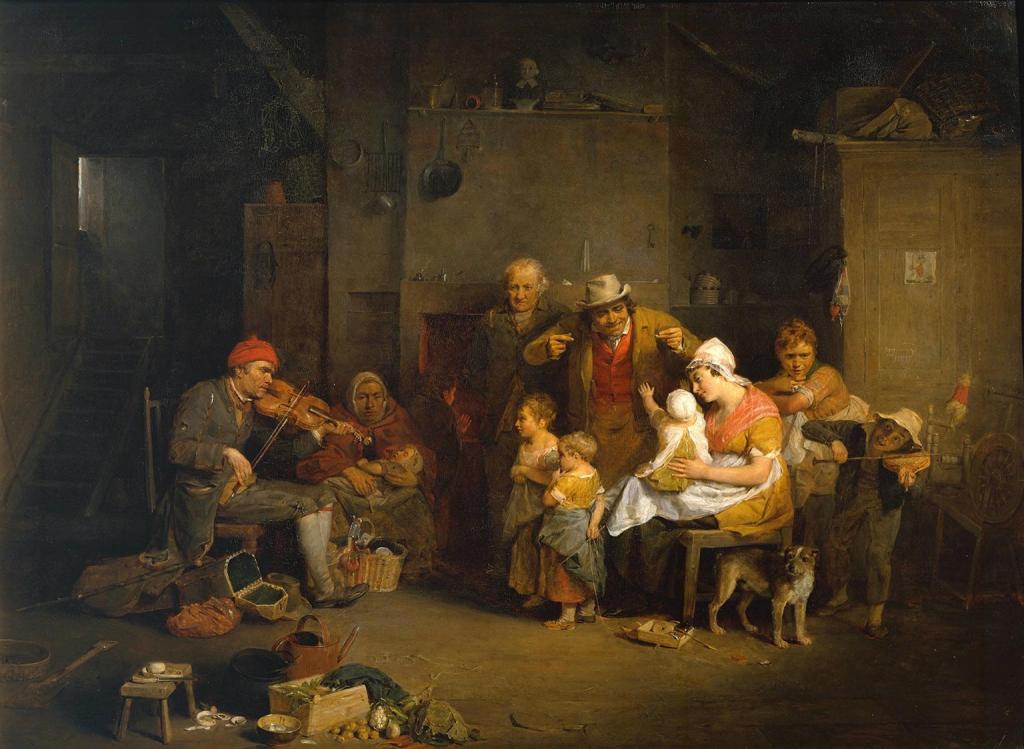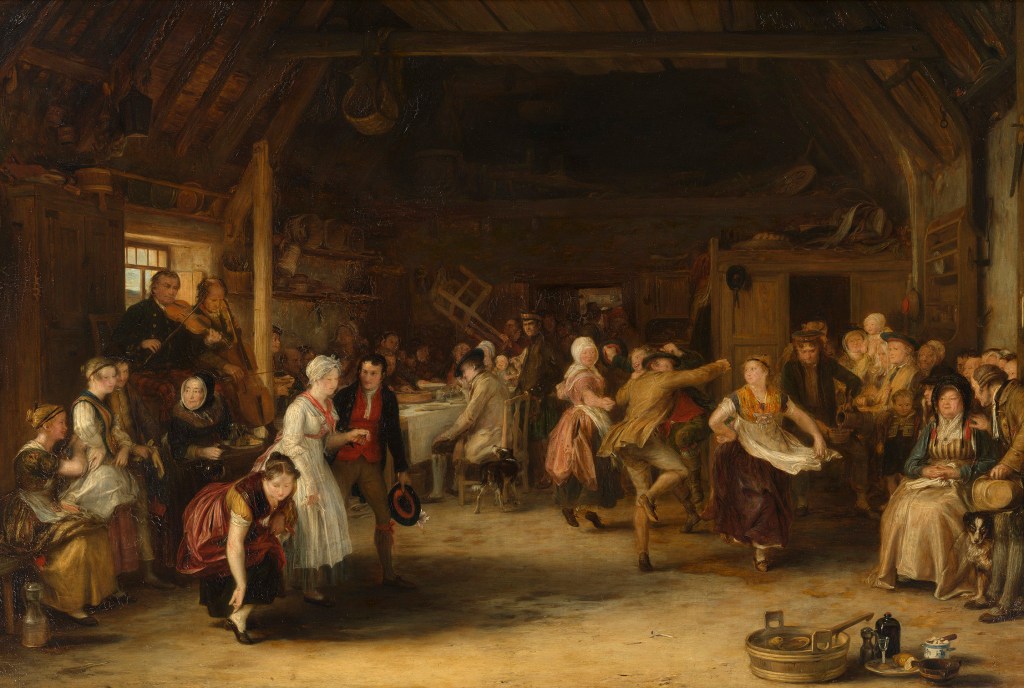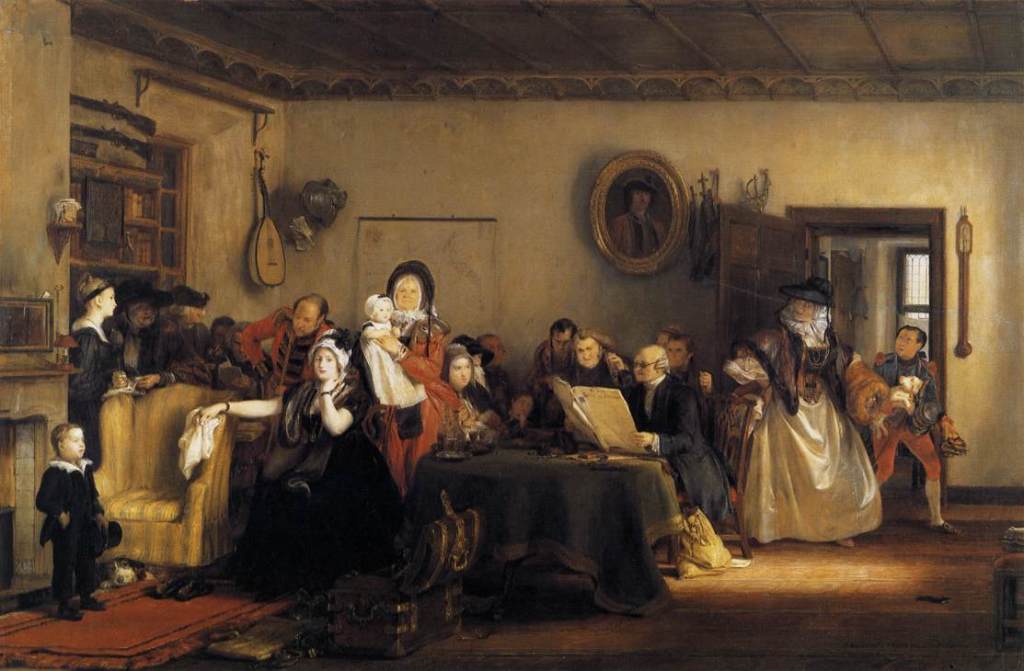Sir David Wilkie (18 November 1785 – 1 June 1841) was a Scottish artist of genre paintings, who also painted historical events and portraits, and was sometimes known as the “people’s painter”, presumably for some of his paintings that depict the lower-class or the middle class fallen on hard times. He was the godfather of author Wilkie Collins (The Woman in White). Wilkie’s paintings are characterised by liveliness, detail, and different or multiple perspectives shown by a number of characters in one painting. Below are four of his paintings, though his best-known one is probably The Chelsea Pensioners Reading the Waterloo Dispatch [1816].

The Blind Fiddler [1806]
In this painting, where Wilkie pays close attention to details, a blind fiddler and his family (a wife, presumably, a lace-maker, an older boy and a baby) come to a country family home to provide entertainment. There is a lot going on in this painting, with each character having a different reaction to the music. The two small children of the family, presumably small trader’s family, seem to be interested in the music, while the baby is being entertained by the older man, probably his father. The small trader family’s son imitates the fiddler by playing on the bellows. Wilkie undoubtedly wanted to contrast the small trader with the poor fiddler, hence our attention is drawn to the colour red of the fiddler’s hat and the houseowner’s waistcoat.
The blind fiddler’s wife is sitting next to the musician, looking vacantly at us. There are tiredness and resignation on her face – the blind fiddler’s family probably travelled a long distance to come to this place, and, in a cold weather, too, as indicated by a small boy (possibly, the fiddler’s other son) who is warming his hands by the fire. The still-empty basket at the feet of the fiddler, and the general aura of listlessness and mockery on the part of the small trader’s family seem to underscore the futility of the blind fiddler’s efforts, making this a somewhat melancholy picture.

The Penny Wedding [1818]
Penny weddings were popular in rural Scotland of the past. A penny wedding meant that the bride and the groom were not financially responsible for any wedding arrangements, including food and dances, and, instead, each of the guests contributed financially to the occasion. As such weddings were often considered by some to be “the height of disorder, conducive to instances of debauchery”, they were discouraged by the Church, and might have already been on their way out by the time Wilkie produced this artwork.
The painting shows a wedding in full swing, probably one taking place in the seventeenth century, with people feasting and dancing. As with other David Wilkie paintings, each of the characters depicted display a different reaction to the event unfolding. Some are shyly watching the newly-weds, while others seem deep in conversation, probably gossing about the newly-married pair. As is the case with The Blind Fiddler, Wilkie employs the colour red to draw out attention to the pair at the centre.

Distraining for Rent [1815]
This painting depicts a farmer’s family coming to terms with the announcement of their immediate eviction as they are no longer capable of paying their rent. The figure of the bailiff looms in the centre of the image, ordering the inventory of the farmer’s goods. As usual, Wilkie is interested in the responses and emotional expressions of each of the family members and their neighbours, female and male, old and young. The farmer and his friends seem to have been caught unawares, with one man of the family in the “hopeless”, sitting position at the table, while the neighbours protest, and the women and children appear to seek comfort with each other.
Distraining for Rent is considered to be one of the most controversial of Wilkie’s painting as it was met with disapproval upon its exhibition in 1816. Its critics were mostly land-owning aristocracy who were enraged by the subject matter presented.

Reading the Will [1820]
This painting was completed as a special commission for the King of Bavaria, and presents a curious scene: a group gathers to hear the reading of a will. It is possible that the lady in red holding the baby is the deceased man’s mother-in-law and is turned away from the solicitor, possibly signalling her disapproval of what she is hearing, although her facial expression does not betray anything. The wife of the deceased, dressed all in black, is sitting down and is also looking neutral, though her arm gesture signals either worry or surprise at what she is hearing. The entrance is made by another lady with a servant-boy and a dog. Interestingly, the dogs in the painting may symbolise loyalty (the old one is hiding under the arm-chair, while the young one is in the servant’s hands, which may also represent “the process of shifting loyalties”), while Wilkie also makes the dead man’s presence felt in the room as his portrait (presumably) hangs on the wall. A cittern is hanging there as well, standing for this family’s happier times, which now appear to be in the past.


Love the realistic details. Reminds me of Breughel.
LikeLiked by 2 people
These paintings are quite moving. Thank you for the commentary as well.
LikeLiked by 1 person
Thank you for sharing this post. It is so interesting amd the paintings are beautiful to look at, they feel real!
LikeLiked by 1 person
Интересный художник!
LikeLiked by 1 person
Such an interesting artist! The details are very impressive, and I love that it doesn’t represent a fixed scene with people posing, but instead some sort of “day in the life”. I think my favourite of these paintings is the Penny wedding because it feels like the people represented are almost moving! Thanks for sharing!
LikeLiked by 1 person
An interesting observation about Penny Wedding. Thanks for reading and commenting!
LikeLiked by 1 person
I knew of Wilkie but didn’t realise he had a connection with Wilkie Collins.
LikeLiked by 1 person
Incredible detail . . . I love paintings that tell multiple stories. Thank you for sharing this.
LikeLiked by 1 person
I love the idea of the Penny Weddings. Rather like a ‘pot luck’ dinner. Love the light effects on the Wilkie painting especially.
LikeLiked by 1 person